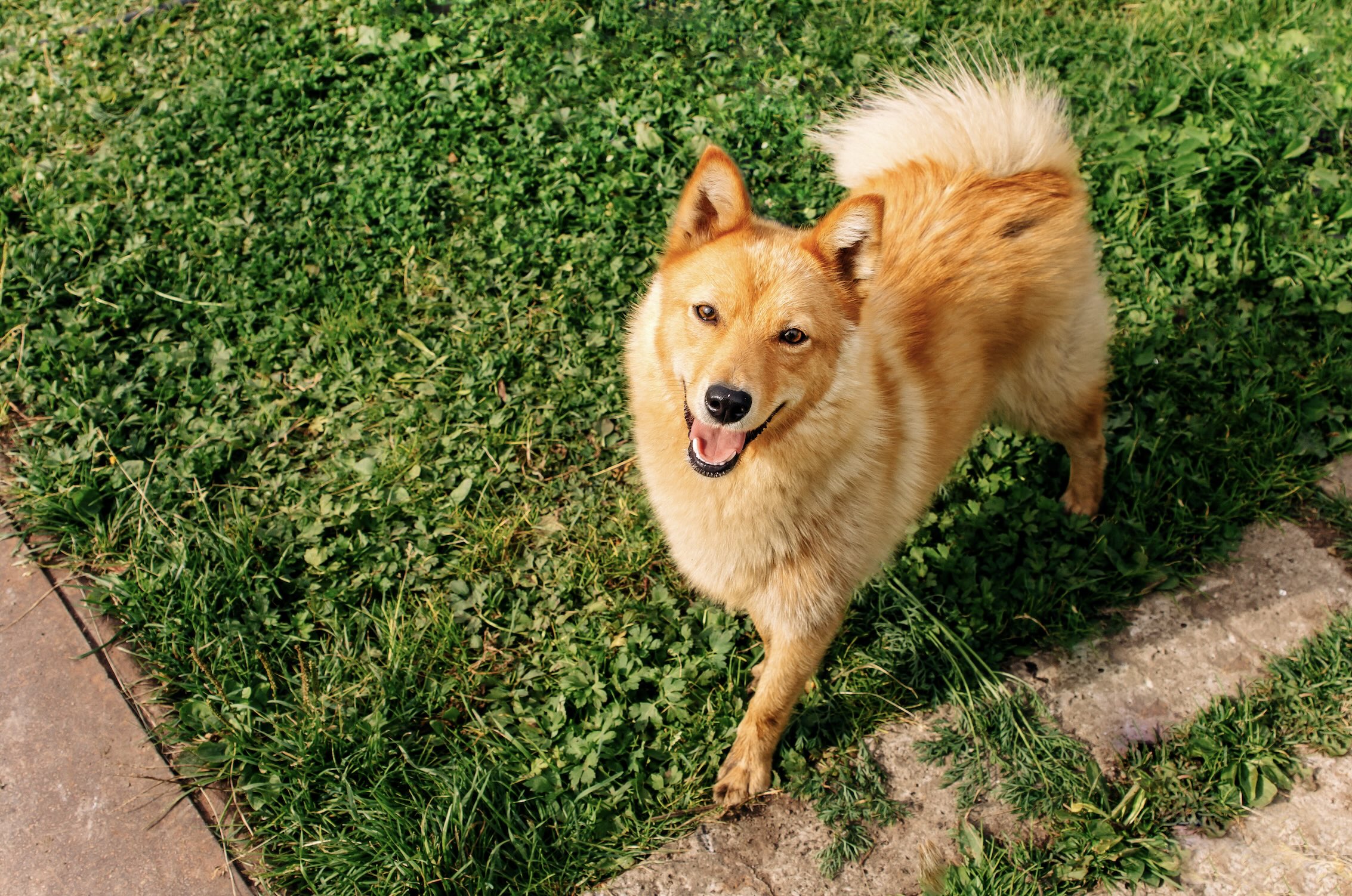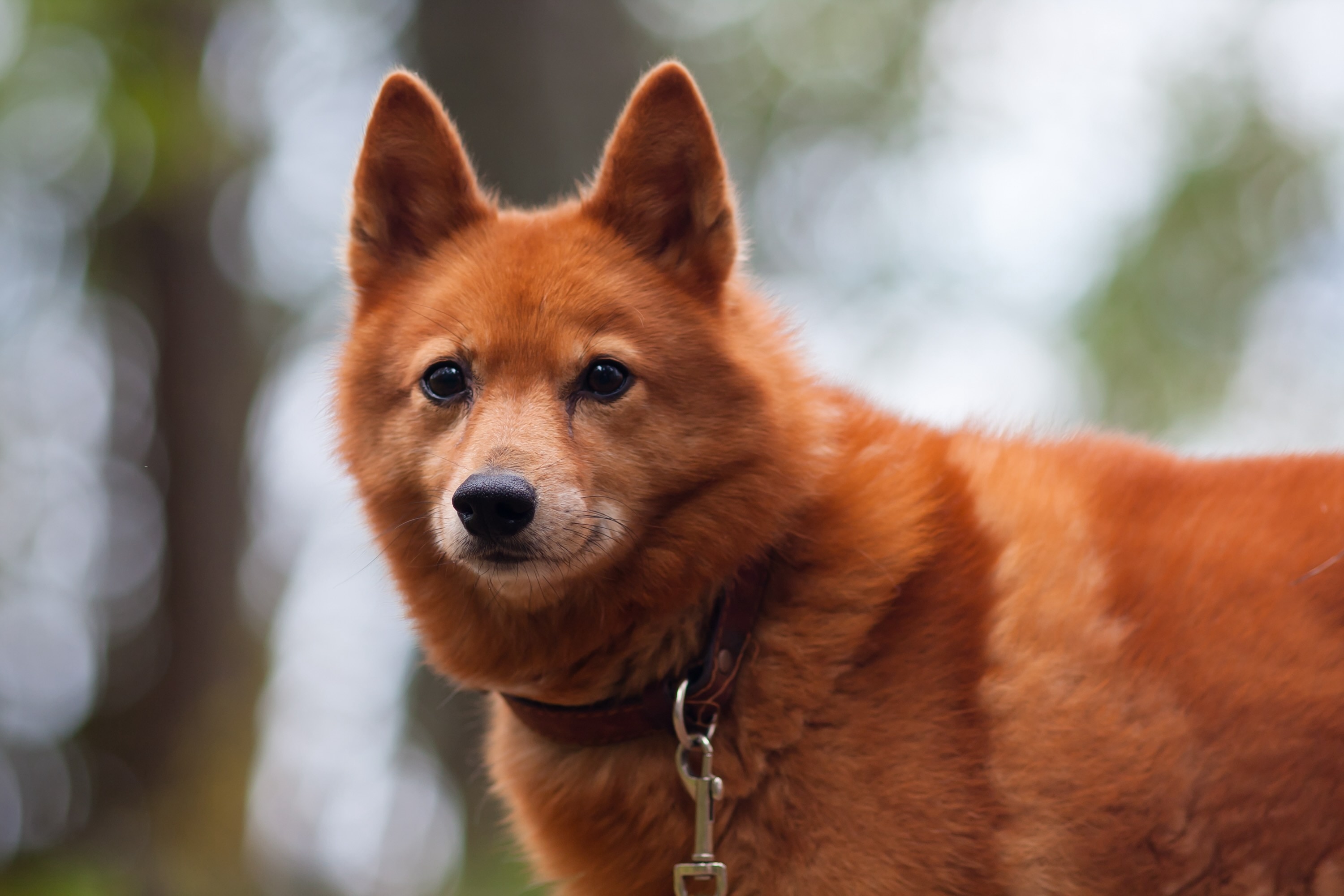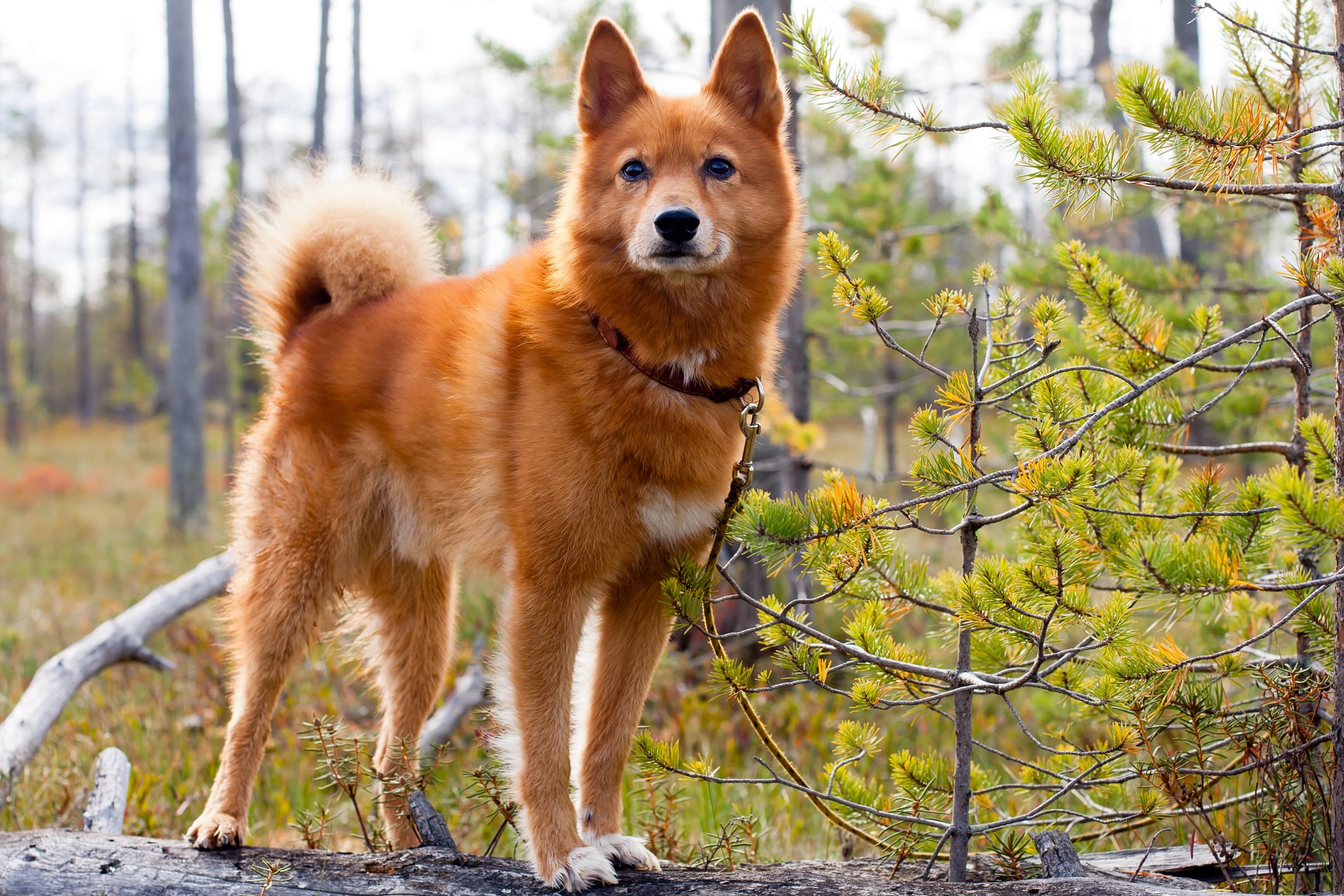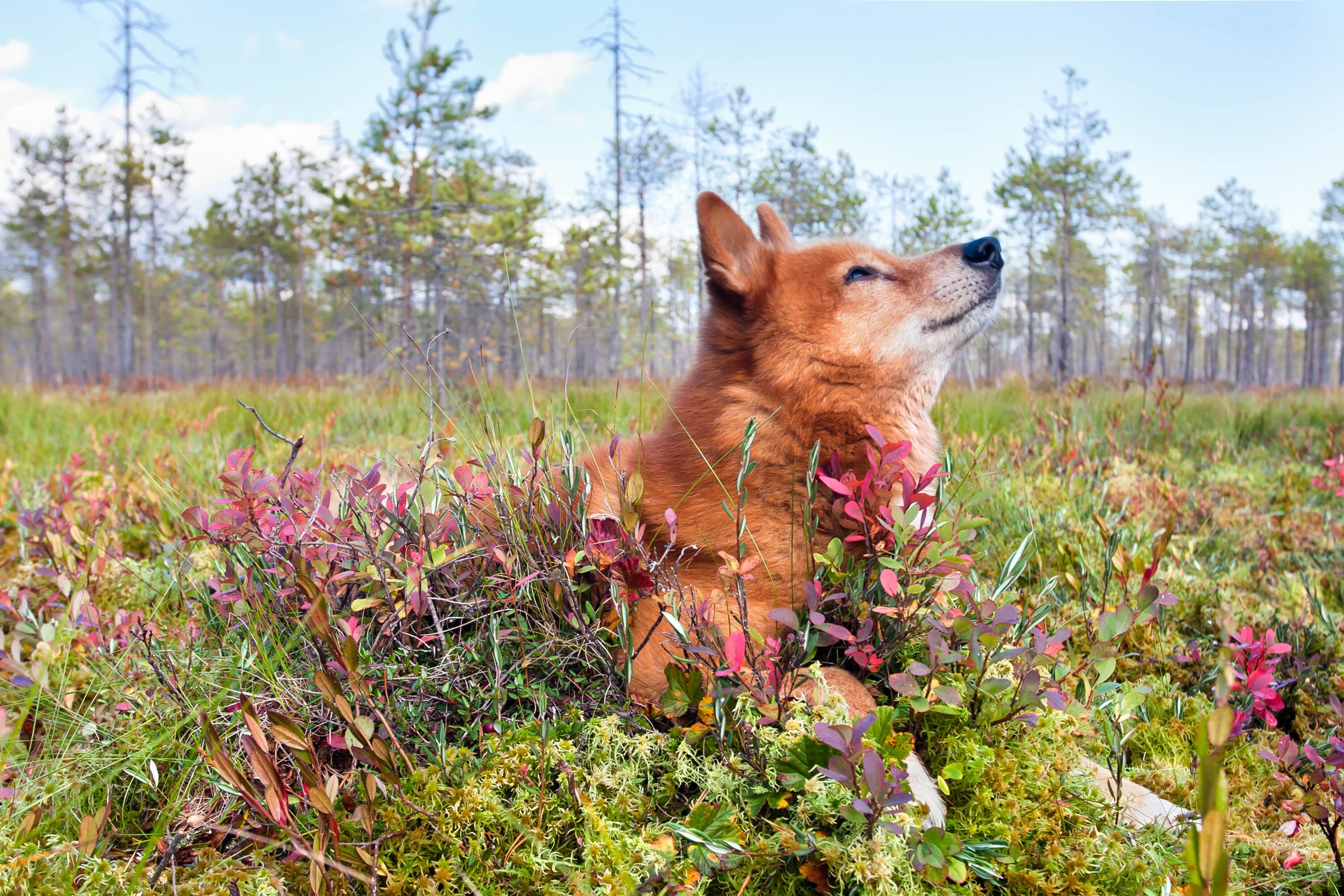Finnish Spitz
PavelRodimov/iStock / Getty Images Plus via Getty Images
Finnish Spitzes—or Suomenpystykorva, as they’re known in their native Finland—were historically used as all-purpose hunters when they arrived in Finland around 3,000 years ago, according to the Finnish Spitz Club of America (FSCA). They eventually began to specialize in hunting game birds.
Finnish Spitzes arrived in the U.S. in the 1960s and were officially placed in the American Kennel Club’s non-sporting group in 1988.
Finnish Spitz dogs, also known as Finnies or Finkies, stand 17.5–20 inches tall and can weigh up to 33 pounds. They’re known for their foxlike features and a dense tail that curls over their back and hip.
Caring for a Finnish Spitz

Finnish Spitzes are known to be playful, alert, and curious dogs that are devoted to their humans. They can be strong-willed and independent like other working spitz breeds, and they can enjoy hunting. They were bred as “barking hunting dogs,” according to the FSCA, so be prepared for a talkative dog (consistent training, however, can help reduce excessive barking).
Finkies are lively, active, and crave social contact. They require daily exercise like long walks or romps through the park. Their beautiful, red-tinged double coats require occasional brushing every week and more often during shedding seasons in the spring and fall.
Though Finnish Spitz dogs are a Nordic breed, they do well in both hot and cold climates—though no dog should be left outside during extreme temperatures.
Finnish Spitz Health Issues

Finnish Spitzes have an average lifespan of 13–15 years and, like all dogs, can be prone to health concerns. To minimize risk for some diseases, purchase a Finnish Spitz puppy from a reputable breeder.
Hip Dysplasia
Hip dysplasia occurs when the bones of a dog’s hip joint don’t fit together as they should while they are growing, leading to instability. Left untreated, the condition will lead to arthritis in dogs.
See your vet if you notice symptoms of hip dysplasia in your Finnish Spitz, such as:
-
Lameness
-
Limping
-
An abnormal, bunny-hopping gait
-
Abnormal sitting positions
-
Trouble standing up
-
Difficulty going up or down stairs
Treating hip dysplasia depends on the condition’s severity and can range from medical management (NSAIDs, joint supplements, weight management, physical therapy) to surgery.
Patellar Luxation
Dogs with patellar luxation have a knee joint that moves out of place as they walk or run. Telltale signs of a luxating patella are a cracking sound from the knee joint, a limp that comes and goes, and a bunny-hopping gait.
Many cases are managed medically with NSAID medication, joint supplements, and weight management. Severe cases may require surgery.
Epilepsy
Epilepsy is a common neurologic disorder affecting the brain and is defined by recurring seizures without a known cause. It is estimated to affect approximately 0.75% of dogs.
Dogs who have a seizure for the first time should be seen immediately by a veterinarian. A vet will conduct a physical and neurologic exam to look for an underlying cause.
Epilepsy is a lifelong condition without a cure, but it can be successfully managed. In most cases, management requires daily medications for life and routine monitoring with your veterinarian.
What To Feed a Finnish Spitz

Feed your Finnish Spitz a well-balanced diet that meets the nutritional standards set by the Association of American Feed Control Officials (AAFCO). Your dog’s food should be formulated for their current life stage: puppy, adult, or senior.
Talk to your vet about the best dog food for your Finnish Spitz.
How To Feed a Finnish Spitz
Adult Finnish Spitz dogs should be fed twice daily, in the morning and evening. By contrast, Finnish Spitz puppies should eat three to four times a day to minimize risk for hypoglycemia (low blood glucose).
How Much Should You Feed a Finnish Spitz?
Follow the feeding guidelines on your dog food packaging; this advises how much to feed your dog based on their weight.
However, your veterinarian can give you the best advice for feeding your dog. They will factor in your Finnish Spitz’s health, age, lifestyle, and weight.
Once your Finnish Spitz puppy is 1 year old, slowly transition their puppy food to a high-quality, small-breed adult formula. Adult food has fewer calories than puppy food to help prevent unwanted weight gain and obesity, to which Finkies can be susceptible.
Nutritional Tips for Finnish Spitz
Healthy Finnish Spitz dogs on a diet that meets the AAFCO standards shouldn’t need nutritional supplements. That said, your vet may recommend certain dog-safe supplements, depending on your pup’s health.
Always talk to your vet before giving your dog supplements.
Behavior and Training Tips for Finnish Spitz
Finnish Spitz Personality and Temperament

Finnish Spitzes are intelligent dogs who are “brave but cautious,” according to the FSCA. They can be aloof and reserved with strangers.
Though they got their start as hunting dogs, Finkies are good family dogs today. They get along well with other pets and children when socialized from puppyhood.
Finnish Spitz Behavior
If you live in an apartment or with nearby neighbors, know that your Finnish Spitz will bark. The breed often barks to alert their family of anything new or approaching because they were historically trained to bark at small and large game. Positive and consistent training can help quiet them.
The Finnish Spitz’s hunting history also means the dogs can maintain a strong prey drive to chase rabbits, squirrels, cats, and other animals. Always keep your dog within a fenced yard or on a leash so they don’t run after something that activates their drive.
Finnish Spitz Training
Patience is key when training Finnish Spitzes, according to the FSCA. Keep training sessions positive, offering treats, toys, playtime, and praise as rewards for following your cues.
Fun Activities for Finnish Spitz
Finnish Spitz Grooming Guide

Their fluffy coat might suggest otherwise, but Finnish Spitzes are relatively low maintenance when it comes to grooming. That’s because they’re sometimes known to clean themselves, according to the breed club.
However, pet parents must still keep up with regular grooming for their Finnish Spitz.
Coat Care
Finnish Spitz coats come in shades of red-gold, from pale honey to dark auburn, according to the FSCA. Their double coat consists of a short, soft, dense undercoat covered by long, straight, harshly textured guard hairs.
The FSCA recommends brushing your Finkie’s coat once a week and more often during the shedding seasons (spring and fall). No fur trimming is needed, except maybe under the pads of their feet or around the eyes.
Skin Care
As long as their coat is well cared for, Finnish Spitzes do not need specific skin care. Bathe your Finkie with a dog-friendly shampoo and conditioner a few times a year, or just when needed if they get particularly dirty.
Eye Care
Finnish Spitzes don’t require much in the way of eye care, but check your dog’s eyes regularly for unusual discharge or other changes. Talk to your vet if you notice anything concerning.
Ear Care
Finnish Spitzes do not require special care for their ears. Ask your vet if cleaning your dog’s ears is necessary and, if so, which ear-cleaning products to use. Always clean your dog’s ears after your dog is in water, such as after swimming or a bath, making sure the canals are dry.
Talk to your vet if you notice signs of an ear infection in your dog, such as discharge, redness, odor, or debris.
Dental Care
The best way to prevent dental disease in your dog is to brush their teeth every day. Use a dog-safe toothpaste and dog toothbrush. Never use human toothpaste, which can be toxic to your dog.
Considerations for Pet Parents
Finnish Spitzes are cute dogs with a fascinating history. They make wonderful family dogs for those looking for loyal, playful companions. They thrive with attention, interaction, and early training. Finkies love to show off their strong voice, so be prepared to teach them where and when it’s not wanted.
They can be cautious with strangers, so early socialization is also a must. Their grooming needs are minimal, and with the right care and nutrition, they can lead happy, healthy lives.
Finnish Spitz FAQs
Are Finnish Spitz good family dogs?
Finnish Spitzes make great family dogs. They’re known to do especially well with children and will be happy to play their hearts out with their smaller human companions.
What is the difference between a Shiba Inu and a Finnish Spitz?
It’s easy to see why some might compare the Shiba Inu to the Finnish Spitz. They share a similar foxlike appearance and curled tail, and both are vocal dogs.
However, Finnish Spitzes are larger in size and have longer coats that come in shades of red, while Shibas can be different colors.
Can Finnish Spitz be left alone?
It’s OK to leave your Finnish Spitz alone for a short amount of time. If you are consistently away from home for most of the day, the Finnish Spitz might not be the best choice. They are loyal pups that love spending time with their humans, and long periods alone might lead to excessive barking.
Are Finnish Spitz easy to train?
Patience is key when training a Finnish Spitz. They can be strong-willed, so training can take time. But with a consistent training routine met with positive reinforcement, they often excel.
